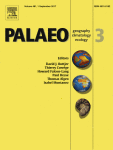View Item
- xmlui.general.dspace_homeCentros Regionales y EEAsCentro Regional Santa FeEEA RafaelaArtículos científicosxmlui.ArtifactBrowser.ItemViewer.trail
- DSpace Home
- Centros Regionales y EEAs
- Centro Regional Santa Fe
- EEA Rafaela
- Artículos científicos
- View Item
Cricket oviposition trace fossils in palaeosols and their stratigraphic significance : the South American Palaeosol Ichnofossil Ages (SAPIAs)
Abstract
The first insect trace fossil in palaeosols attributed to the oviposition of crickets is represented by openings composed of two to four, but usually three, perforations with a tripartite pattern. This pattern is compatible with the cross section of the distal ovipositor of some crickets. The new ichnotaxon Bellosichnus tripartitus igen. isp. nov. represents a novel architectural design among insect trace fossils in palaeosols. It may reflect true
[ver mas...]
The first insect trace fossil in palaeosols attributed to the oviposition of crickets is represented by openings composed of two to four, but usually three, perforations with a tripartite pattern. This pattern is compatible with the cross section of the distal ovipositor of some crickets. The new ichnotaxon Bellosichnus tripartitus igen. isp. nov. represents a novel architectural design among insect trace fossils in palaeosols. It may reflect true ovipositions or the behavior of testing soil with the ovipositors performed by crickets. In accordance, this trace fossil would be indicative of the surface soil horizon. Bellosichnus tripartitus is abundant in the lower section of the Sarmiento Formation (middle Eocene Casamayoran Age) and it is almost absent before and after this interval in other terrestrial successions of Patagonia. It is a trace fossil with high stratigraphic significance. Bellosichnus tripartitus and other insect trace fossils in palaeosols with similar stratigraphic significance comprise several assemblages, which are representative of different ages along the Cenozoic of southern South America. Such assemblages are typical of particular ages that are named herein South American Palaeosol Ichnofossil Ages (SAPIAs). The SAPIAs run in parallel with the South American Land Mammal Ages (SALMAs). The SAPIAs would be useful to make predictions not only on ages, but also on possible mammal faunas and palaeoenvironments in understudied palaeontological localities.
[Cerrar]

Author
Genise, Jorge Fernando;
Sánchez, María Victoria;
Bellosi, Eduardo Sergio;
Cantil, Liliana Fernanda;
Krause, Javier Marcelo;
González, Mirta Gladys;
Sarzetti, Laura Cristina;
Verde, Mariano;
Puerta, Pablo;
Frana, Jorge;
Fuente
Palaeogeography, palaeoclimatology, palaeoecology 481 : 64-76. (September 2017)
Date
2017-09
ISSN
0031-0182
Formato
pdf
Tipo de documento
artículo
Palabras Claves
Derechos de acceso
Restringido
 Excepto donde se diga explicitamente, este item se publica bajo la siguiente descripción: Creative Commons Attribution-NonCommercial-ShareAlike 2.5 Unported (CC BY-NC-SA 2.5)
Excepto donde se diga explicitamente, este item se publica bajo la siguiente descripción: Creative Commons Attribution-NonCommercial-ShareAlike 2.5 Unported (CC BY-NC-SA 2.5)

